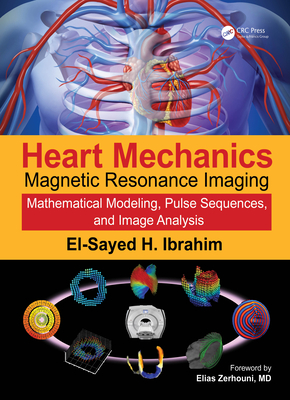Read Online Heart Mechanics: Magnetic Resonance Imaging--Mathematical Modeling, Pulse Sequences, and Image Analysis - El-Sayed H Ibrahim file in PDF
Related searches:
Cardiac deformation parameters and rotational mechanics by
Heart Mechanics: Magnetic Resonance Imaging--Mathematical Modeling, Pulse Sequences, and Image Analysis
Echocardiography and cardiac magnetic resonance in children with
Heart morphology, function, and diseases — Mayo Clinic
Cardiac Magnetic Resonance Imaging - Brigham and Women's Hospital
Magnetic Resonance Imaging (MRI) of the Heart - Heart and
Cardiac magnetic resonance (mr) elastography noninvasively provides mechanics-based image contrast. The measurement of mechanical parameters is otherwise possible only by palpation or invasive pressure measurement. Measurement of parameters of myocardial shear stiffness is considered to be diagnostically beneficial especially in patients with diastolic dysfunction due to diffuse myocardial disease.
Cardiac magnetic resonance imaging (mri) uses a powerful magnetic field, radio waves and a computer to produce detailed pictures of the structures within and around the heart. Cardiac mri is used to detect or monitor cardiac disease and to evaluate the heart's anatomy and function in patients with both heart disease present at birth and heart diseases that develop after birth.
Cardiovascular magnetic resonance (cmr) and echocardiography are both commonly used for these studies [1, 2], however cmr is generally considered to be the more accurate modality. Using cine imaging, left ventricular (lv) volume, stroke volume, ejection fraction, and wall thickening can be quantified.
Patients with prosthetic valves (mechanical or bioprosthetic) or coronary stents may have an indication to undergo magnetic resonance imaging (mri). Sometimes these patients are excluded from mri on the basis that they have an implant that makes them unsuitable for the magnetic resonance (mr) environment. The aim of this paper is to educate patients and physicians about the safety of mri in individuals with prosthetic heart valves or coronary stents.
28 oct 2020 7t cardiac magnetic resonance imaging (mri) introduces several of heart mechanics in both normal and pathophysiological conditions; thus,.
30 nov 2020 cardiovascular magnetic resonance-derived left ventricular mechanics—strain, cardiac power and end-systolic elastance under various.
8 nov 2016 magnetic resonance imaging of cardiac strain pattern following transplantation of human tissue engineered heart muscles.
Book magnetic resonance imaging—mathematical modeling, pulse sequences, and image analysis.
The american heart association explains that magnetic resonance imaging (mri) is a non-invasive test that uses a magnetic field and radiofrequency waves to create detailed pictures of organs and structures inside your body. It can be used to examine your heart and blood vessels, and to identify areas of the brain affected by stroke.
Magnetic resonance imaging provides insight into myocardial mechanics after a heart attack. Quantifying the damage caused to specific parts of the heart by cardiac arrest is key to providing.
Cardiac magnetic resonance imaging (cmr), three-dimensional diagnostic imaging technique used to visualize the heart and its blood vessels without the need.
In the clinical magnetic resonance imaging (mri) setting, it is often necessary to manage patients with heart valve prostheses [including transcatheter aortic valve replacements (tavr), transcatheter aortic valve implantation (tavi ) devices, percutaneous aortic valve.
The cardiovascular magnetic resonance group at linköping university the heart generates blood flow by contraction of muscle fibers oriented in a complex a basic level by assessing blood flow dynamics and wall mechanics, and tissu.
Advanced magnetic resonance imaging techniques for measuring heart mechanics� doi link for advanced magnetic resonance imaging techniques for measuring heart mechanics. Advanced magnetic resonance imaging techniques for measuring heart mechanics book.
Mri techniques have been recently introduced for non-invasive qualification of regional myocardial mechanics, which is not achievable with other imaging modalities. Covering more than twenty-three years of developments in mri techniques for accessing heart mechanics, this book provides a plethora of techniques and concepts that assist readers choose the best technique for their purpose.
Based on research and clinical trials, this book details the latest research in magnetic resonance imaging (mri) tagging technology related to heart mechanics. It covers clinical applications and examines future trends, providing a guide for future uses of mri technology for studying heart mechanics.
Mri techniques have been recently introduced for non-invasive qualification of regional.
Magnetic resonance imaging (mri) is a test that uses a large magnet, radio signals, and a computer to make images of organs and tissue in the body.
Keywords: cardiovascular magnetic resonance, heart failure, late gadolinium enhancement, systolic and diastolic mechanics in stress cardiomyopathy.
Cardiac magnetic resonance imaging (cmr) has grown as an imaging modality to provide additive and complementary information to echocardiography.
Covering more than twenty-three years of developments in mri techniques for accessing heart mechanics, this book provides a plethora of techniques and concepts that assist readers choose the best technique for their purpose. It reviews research studies and clinical trials that implemented mri techniques for studying heart mechanics.
Subtitle of host publication, magnetic resonance imaging-mathematical modeling, pulse sequences.
With magnetic resonance imaging (mri), a powerful magnetic field and radio waves are used to produce detailed images of the heart and chest. This expensive and sophisticated procedure is used predominantly for the diagnosis of complex heart disorders that are present at birth (congenital) and to differentiate between normal and abnormal tissue.
Mri techniques have been recently introduced for non-invasive qualification of regional myocardial mechanics, which is not achievable with other imaging.
Because cardiac magnetic resonance imaging also acquires information about the heart rhythm, it can create clear moving images of the heart throughout its pumping cycle. This allows cardiac magnetic resonance imaging to display abnormalities in cardiac chamber contraction and to show abnormal patterns of blood flow in the heart and great vessels.
Buy heart mechanics: magnetic resonance imaging—mathematical modeling, pulse sequences, and image analysis: read books reviews - amazon.
Cardiac magnetic resonance (cmr) imaging allows comprehensive assessment of myocardial function and tissue characterization in a single examination after.
Tissue tracking technology of routinely acquired cardiovascular magnetic resonance (cmr) cine acquisitions has increased the apparent ease and availability of non-invasive assessments of myocardial deformation in clinical research and practice.

Post Your Comments: